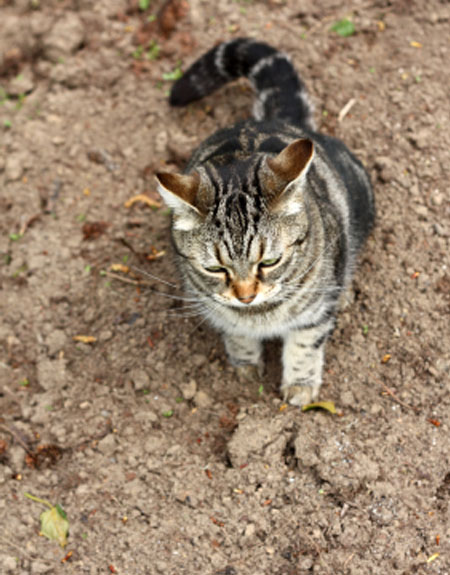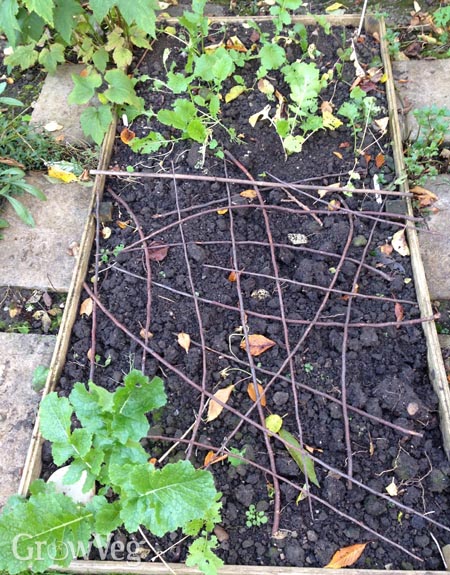How To Keep Cats Out Of My Vegetable Garden
Keeping Cats off Vegetable Beds

Last week Barbara wrote about growing plants that cats will love – a delightful way to indulge your favorite pet. However, not everyone has such a positive relationship with cats in the garden. For those of us gardening in urban or suburban areas they can seem more of a nuisance when our specially prepared vegetable beds become the local toilet for the neighborhood felines. Having a row of precious seedlings dug up, or finding cat-poo when planting can be frustrating to say the least. So what can be done to persuade them to keep away?
The first thing to realize is that it's quite natural for cats to seek out neighboring patches of earth to use as a toileting area. Unless the owners have trained them to use a litter tray at an early age most cats will prefer to find an area outside their own garden territory. When you consider how many gardens consist of lawns, densely planted borders and low-maintenance paved areas it is no surprise that they often make a beeline for the recently dug bare soil of vegetable beds.
Although the behavior is understandable it certainly isn't desirable to have cat feces near vegetables as they contain a number of disease-bearing pathogens including those that cause toxoplasmosis. Washing home-grown food carefully is one part of the equation but to be on the safe side it's best to try and keep cats away.

Deterrents
There are hundreds of commercial products available to deter cats but you only have to peruse a few gardening forums to discover that many of them aren't as effective as the manufacturers would have you believe. Deterrents should also be evaluated for safety as quite a few are not suitable for vegetable gardens. For example, you will often see mothballs recommended but they are highly toxic to young children, dogs and cats and contain pesticides that you are unlikely to want near edible plants.
Generally, deterrents fall into the following categories:
- Smells: Strong smelling substances that cats don't like are often recommended such as orange peel, coffee grinds (try your local cafe for used grinds), pepper etc. These usually need replenishing every few days, particularly after rain. Commercial variants often contain the scents of predators e.g. Silent Roar (contains 'sterilised essence of lion dung') or Shake-Away (with coyote and fox urine).
- Sounds: Ultrasonic cat repellent devices work by emitting a high-pitched sound, which cats don't like but humans can't hear, when there is movement nearby. Battery operated models are available although wired versions are more economical in the long run. An alternative sometimes used is wind chimes but they are rarely popular with neighbors.
- Visual Warnings: Some people place short lengths of old hosepipe amongst their plants to look like snakes which cats will keep away from. Bottles of water or CDs strung together can give shifting light patterns that are said to make cats wary.
- Barriers: The most effective barrier is to net each vegetable bed but it takes time and money to do this. Another approach is to place spiked strips on all surrounding fences but cats are extremely good at navigating obstacles. Alternatively you can place many spikes in the ground – these can be small sticks about every two inches (pea sticks work well) or trimmings from spiky plants such as roses or hawthorns that will make it uncomfortable for a cat to dig. Unfortunately they also make it very uncomfortable to weed or plant in the area!
- Plants: A number of plants are said to be unattractive to cats including lavender, lemon balm and the 'scaredy cat plant' Coleus canina. They work by producing smells or having a texture that cats don't like. Most are annuals and can be raised from seeds or cuttings but that means they are unlikely to be fully grown in spring when your soil needs protection most.
- Water: Cats try to avoid getting wet and a sudden blast of water can be an effective deterrent. Motion activated sprays are one way of achieving this although they are quite an expensive option.
- Animals: Surprisingly owning a dog is not a good deterrent. However, owning a cat will usually keep others away because they mark out your garden as their territory, though that's not always a desirable option.

What Works
No single method for deterring cats is 100% effective and many are simply too expensive when scaled to the size of a large vegetable garden. However, there are some good principles to follow when deciding on a course of action:
- Clear Up and Replace Scent with Strong Smells: Cats are creatures of habit that use smell to locate their toileting areas. If you already have a problem then the first step is to remove the existing poo, water the surrounding earth to wash the smell away and then spread scented deterrents in the area (citrus, coffee grinds etc)
- Use Ground Coverings Where Possible: Keeping the soil covered for as much of the year as possible is good gardening practice anyway so make good use of green manures (cover crops) and mulches.
- Make Cats Feel Unsure: Cats don't like surfaces that feel tangly or wobbly. Stretching netting over beds, running string between posts at the top of fences and using light mulches that a cat's feet will sink into will all make a cat feel that it's not on solid ground, encouraging it to go elsewhere.
- Don't be Seen: The classic mistake (I plead guilty to this!) is to chase cats from your garden. The problem is that they then associate you with the danger and it seems they like the challenge of outwitting you! Instead, cat psychology says that we should look for ways to have the cat associate the garden with danger, rather than the human, so a jet of water apparently coming from nowhere will be more likely to succeed than an angry gardener.

There are no easy answers to the roaming nature of cats – I wish there were. However, with a combination of the ideas mentioned above, some success can be had, or at least the problem can move on to someone else's garden where vegetables aren't being grown. If you are still struggling then, as a declaration of war, you could try the technique mastered by my retired parents-in-law: sitting in their conservatory with a loaded super-soaker pointed through the open door – a method that they swear has been the most effective of all!
If you have had success in keeping cats from your garden please do share your tips below.
< All Guides
How To Keep Cats Out Of My Vegetable Garden
Source: https://www.growveg.com/guides/keeping-cats-off-vegetable-beds/
Posted by: millerpithenclacke.blogspot.com

0 Response to "How To Keep Cats Out Of My Vegetable Garden"
Post a Comment